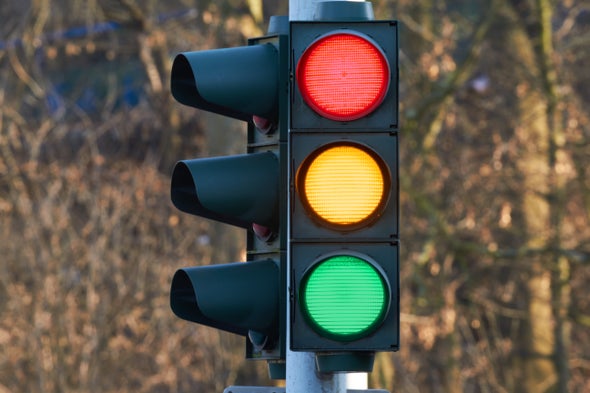Do Red Light Cameras Flash

Red Light Cameras May Non Make Streets Safer
Fear of fines may fuel more sudden stops and rear-end accidents

The following essay is reprinted with permission from The Conversation, an online publication covering the latest enquiry.
The auto is a killer. In the U.South., 36,675 people died in traffic accidents in 2014. The year before, ii.iii 1000000 people were injured in traffic accidents.
During the by decade, over 438 U.Due south. municipalities, including 36 of the fifty near populous cities, have employed electronic monitoring programs in order to reduce the number of accidents. Red light camera programs specifically target drivers that run red lights.
In a study I co-authored with economist Paul J. Fisher, we examined all police-recorded traffic accidents for iii big Texas cities over a 12-year period – hundreds of thousands of accidents. We found no show that crimson calorie-free cameras improve public safe. They don't reduce the full number of vehicle accidents, the full number of individuals injured in accidents or the total number of incapacitating injuries that involve ambulance transport to a hospital.
Red calorie-free cameras
In a red light photographic camera program, a camera is installed in a location where it can take photos or video of vehicles as they pass through the intersection. City employees or private contractors so review the photos. If a vehicle is in the intersection when the low-cal is red, then a ticket is sent to the person who registered the vehicle.
These programs aim to reduce cantankerous-street collisions. The idea is that drivers, fearing a higher take chances that they will exist fined, will be more than likely to end, lowering the number of angle, or "T-bone," accidents.
Evidence clearly shows that photographic camera programs are constructive at decreasing the number of vehicles running cherry-red lights. In one report in Virginia, red calorie-free cameras reduced the number of total drivers running ruddy lights by 67 percent.
However, cameras can have contradictory effects on traffic safety. Some drivers who would accept otherwise continued to keep through the intersection when the light is xanthous or scarlet will now attempt to end. That ways that the number of accidents caused by vehicles not stopping at a blood-red light will likely decrease.
Only the number of accidents from stopping at a red calorie-free – such as rear-end accidents – is likely to increase. That's not an inconsequential side issue. Some drivers volition endeavour to stop, accepting a higher gamble of a non-bending accident similar getting rear-ended, in gild to avert the expected fine.
The overall outcome of a camera program on vehicle accidents and injuries depends on the net affect of these two furnishings. Overall commuter safety could increase or decrease.
Our study
In our study, nosotros focused on Houston, a major U.S. city that operated a big camera program at 66 intersections betwixt 2006 and 2010.
One reason nosotros chose Houston is to take advantage of the natural experiment that occurred when city residents passed a referendum in November 2010 to ban the cameras.
We accessed detailed accident information on every traffic blow in Texas from 2003 to 2014 through a public records information request. The data included the blow's precise geocoded location; the type of blow; whether the driver ran a red light; and details on any injuries.
When the Houston cameras were removed, bending accidents increased by 26 percent. Yet, all other types of accidents decreased by 18 percent. Approximately ane-third of all Houston intersection accidents are bending accidents. This suggests that the program'south drawbacks canceled out its benefits.
Our study showed no evidence that cameras reduce the total number of accidents. We estimate that total accidents are reduced by a statistically insignificant iii per centum afterward the cameras are turned off.
Too, there'southward no prove that the camera programme reduced the number of traffic-related injuries or the likelihood of incurring an incapacitating injury.
The elevated number of traffic accidents at urban intersections is a serious public health issue. Simply our study shows that Houston'due south camera programme was ineffective in improving traffic prophylactic. Electronic monitoring is not the solution.
This article was originally published on The Conversation. Read the original commodity.
Source: https://www.scientificamerican.com/article/red-light-cameras-may-not-make-streets-safer/
Posted by: shepardthalow.blogspot.com


0 Response to "Do Red Light Cameras Flash"
Post a Comment